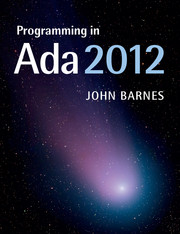Summary
In the previous chapters, we introduced some concepts of Ada and illustrated the general appearance of Ada programs with some simple examples. However, we have so far only talked around the subject. In this chapter we get down to serious detail.
Regrettably it seems best to start with some rather unexciting but essential material – the detailed construction of things such as identifiers and numbers which make up the text of a program. However, it is no good learning a human language without getting the spelling sorted out. And as far as programming languages are concerned, compilers are usually very unforgiving regarding such corresponding and apparently trivial matters.
We also take the opportunity to introduce the notation used to describe the syntax of Ada. In general we will not use this syntax notation to introduce concepts but, in some cases, it is the easiest way to do so. Moreover, if the reader wishes to consult the ARM then knowledge of the syntax notation is necessary. For completeness and easy reference the full syntax is given in Appendix 3.
Syntax notation
The syntax of Ada is described using a variant of Backus-Naur Form (BNF). In this notation, syntactic categories are represented by lower case names; some of these contain embedded underlines to increase readability. A category is defined in terms of other categories by a sort of equation known as a production. Some categories are atomic and cannot be decomposed further – these are known as terminal symbols.
Information
- Type
- Chapter
- Information
- Programming in Ada 2012 , pp. 65 - 72Publisher: Cambridge University PressPrint publication year: 2014
